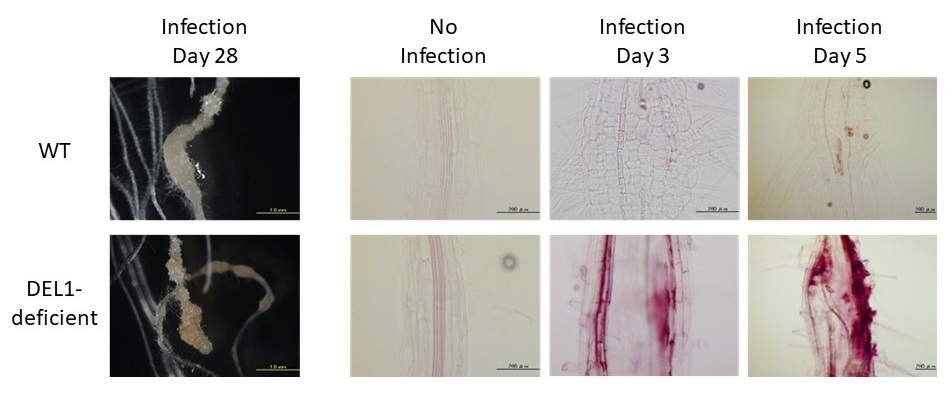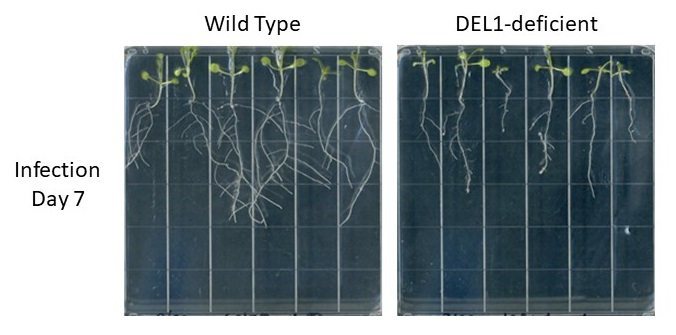The balancing act between plant growth and defense
Plant gene found to regulate control over whether a plant grows or puts up its defenses against pathogens.
Kumamoto University researchers have pinpointed the mechanism that regulates the balance between plant growth and defense. Plants synthesize and accumulate protective hormones to protect them from pathogen infections, but excessive accumulation significantly hinders plant growth. Researchers found that the DEL1 gene plays a role in balancing growth and defense of plants infected with nematodes. This finding is expected to contribute to the improvement of agricultural crop varieties and the identification of infection mechanisms of various pathogens.
Plants grow continuously throughout their life but growth becomes suppressed and energy is put into defense responses, like the synthesis of the defense hormones salicylic acid and lignin, when attacked by pathogens. When the accumulation of salicylic acid and lignin becomes excessive, plants show significant growth inhibition. It is therefore believed that plants keep an appropriate balance between growth and defense. However, this type of balance regulating mechanism has only been reported in leaves; the existence of a similar mechanism in roots was unknown.
To test for a mechanism in roots, researchers infected wild-type and DEL1-deficient Arabidopsis, a plant related to cabbage or mustard frequently used in plant-based genetic research experiments, with Meloidogyne Incognita, a parasitic roundworm that infects roots. After nematode infection, DEL1 deficient plants exhibited excessive salicylic acid accumulation and infected sites turned brown, a strong reaction color, when stained with lignin. Additionally, the DEL1 deficient plant had a higher nematode resistance than the wild type, indicating that the DEL1 gene acts to suppress the defense response against nematodes. Furthermore, when the DEL1 deficient plant was infected with nematodes, significant root growth inhibition was observed.
This is the first study to demonstrate that the DEL1 gene plays an important role in the growth vs defense balancing mechanism in plant roots.
"This study should allow us to develop more diverse strategies for controlling pathogens," said study leader Professor Shinichiro Sawa. "For example, plant varieties that have excellent appearance, taste, and resistance traits often have slow growth and low yield. By focusing on genes involved in growth vs defense balance regulation like the DEL1 gene, increased yields and better plant varieties may be produced. We believe that direct control over DEL1 activity will improve our ability to breed pest resistant, high yield plants."
This research was posted online in Scientific Reports on 1 June 2020.
[Source]
Nakagami, S., Saeki, K., Toda, K. et al. The atypical E2F transcription factor DEL1 modulates growth–defense tradeoffs of host plants during root-knot nematode infection. Sci Rep 10, 8836 (2020).
https://doi.org/10.1038/s41598-020-65733-3
[Publication URL]
https://www.nature.com/articles/s41598-020-65733-3
[Fund(s)]
Grant-in-Aid for Scientific Research (Kakenhi) from the Japanese Ministry of Education Culture Sports Science and Technology (MEXT)
[Number(s]]
JP24114009, JP24370024, JP16K14757, JP17H03967, JP18H05487, JP20H00422
[Media 1]

Lignin accumulation in wild type and DEL1 deficient plants
The nematode-infected site of the DEL1 deficient plants became brown. When stained with lignin, the infection site produced a strong reaction color (red).
[Images Details]
CREDIT:
Professor Shinichiro Sawa
USAGE RESTRICTIONS:
Right image adapted from figure 3A of Nakagami, S., et al.
This image is made available under the terms of Creative Commons Attribution 4.0 International License. Any further distribution of this work must follow the terms of this license.
[Media 2]

Root growth in wild type and DEL1 deficient plants
Nematode infection of DEL1 deficient plants resulted in significant root growth inhibition.
[Images Details]
CREDIT:
Professor Shinichiro Sawa
USAGE RESTRICTIONS:
Adapted from figure 4A (inoculated) of Nakagami, S., et al.
This image is made available under the terms of Creative Commons Attribution 4.0 International License. Any further distribution of this work must follow the terms of this license.
